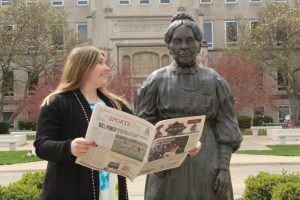It’s no secret that the United States has been falling short in education compared to the rest of the world.
Not only are American students failing compared to other countries on tests in math and science, but now American students are dropping out of high school more often than students elsewhere.
“I’m running to make sure that America has the best education system on Earth, from pre-K all the way to post-graduate,” President Barack Obama said in July. “And that means hiring new teachers, especially in math and science.”
While reform has been on the minds of many politicians from No Child Left Behind and Race to the Top, there hasn’t been a system in place that’s been able to work across the country.
That’s why the Chicago Teacher’s Union strike is so important. Yes, a pay increase, class sizes, and resources are important to the teacher’s union, but the real fight here is how teachers will be measured.
Chicago Teachers Union President Karen Lewis said up to 6,000 teachers could lose their jobs under the current evaluation of teachers.
“This is no way to measure the effectiveness of an educator,” Lewis said Sunday. “Further, there are too many factors beyond our control which impact how well some students perform on standardized tests such as poverty, exposure to violence, homelessness, hunger and other social issues beyond our control.”
How do we fix the system to grade teachers for sub-par standardized test scores? Are standardized test scores the fairest way to grade students’ progress?
About 350,000 students in the Chicago Public Schools (CPS) system haven’t gone to school this week.
And these students aren’t the ones who have the flexibility to skip school. The district reported a 60.6 percent gradation rate for 2012, their highest mark in a decade. However, a Chicago Tribune study in 2006 found that the CPS has a history of inflating their percentages. This may be considered a high mark for the CPS, but it’s still miles off of the U.S. high school national graduation rate of 77 percent.
These are the students of our future. Look at the charts for how much more a person who graduates from college earns compared to a person who graduates from high school. Yet, many CPS students don’t get a chance to dream about college. A University of Chicago study in 2005 found that of the CPS high school graduates, about 33 percent enroll in college one year after graduating. And only 35 percent of students graduate from college with a bachelor’s degree within six years.
Is that the best educational system that we can settle for?
Read a Chicago newspaper or watch it’s local news to see how much violence is currently in Chicago. To change this cycle from continuing, somebody needed to take a drastic step.
The teacher’s union is taking that drastic step. Instead of students sitting in rooms without air conditioning, having too many students in one class, or having to use torn up textbooks to read from, the teachers are taking a stand for change.
Is a strike that takes more than 350,000 students out of school an ideal situation? Absolutely not, and most of the teachers would agree with that. But, how do you get your message across when nothing has changed in the past?
This is a fight about solutions. The teacher’s union is fighting for solutions to help our inner-city students. Although I’m not sure what the correct answer is for solving the evaluation process of students and teachers, I think it’s a fight worth fighting.



